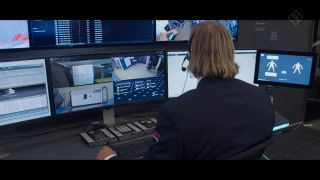Data center physical security with mmWave technology – a solution to your challenges
State-of-the-art mmWave security scanners such as the R&S®QPS201 and R&S®QPS Walk2000 effectively address the main challenges in data center security.
Security staff shortages:
Finding qualified security personnel able to manage and monitor the extensive security protocols necessary at data centers is an ongoing challenge. Shortages may result in overworked staff, leading to increased risks of human error and possible security gaps.
Rohde & Schwarz QPS security scanners release security staff from routines – so they can focus on their core tasks – through:
- Fast, effective screening with no or minimum operator interaction needed
- The support of IP integration for remote self-screening checkpoints
- AI-based automatic anomaly detection and precise positioning, which limit additional manual searches to an absolute minimum and support remote alarm resolution. This means that uncomfortable and time-consuming full-body pat-downs are not needed anymore.
Cost-intensive 24/7 monitoring:
Maintaining continuous, around-the-clock monitoring of a data center is expensive, requiring substantial investment in both technology and personnel. The need for remote screening operations to facilitate low-volume access to critical areas has become increasingly apparent.
The R&S®QPS security scanners reduce staffing needs and costs and provide:
- Integration with remote self-screening checkpoints
- Possibility to integrate with a building’s IoT infrastructure and implementing physical security as part of a holistic, fully integrated layered security
Evolving threats and data-bearing devices:
Data centers are constantly confronted with evolving threats, such as sophisticated methods for smuggling data-bearing devices (e.g. USB drives and portable storage devices) as well as any object and substance that can be used for sabotage and damage to the servers. The challenge for data center security solutions lies in covering this wide range of metallic and non-metallic threats and adapting to the constantly advancing technology landscape. Staying ahead of the latest threat vectors and ensuring that security measures can detect emerging types of devices remains an ongoing struggle.
With the help of innovative microwave imaging (MI) technology, mmWave security scanners are able to detect an extremely wide range of body-bound contraband, hidden threats, and other unwanted metallic and non-metallic objects such as ceramics, plastics, glass, liquids, organics, granulates, powders, jelly, and much more.
Rohde & Schwarz security scanners utilize deep learning mechanisms and operate with high-precision, AI-based automatic detection algorithms, specifically optimized for data center security needs and are constantly adapted to evolving threats and needs. AI-based automatic anomaly detection is superior to human-based recognition and delivers 24/7 operator-independent screening quality.
Efficient and smooth screening:
Ensuring thorough screening of individuals entering the data center, whilst minimizing delays, poses a significant challenge.
When implementing R&S®QPS body scanners, data centers benefit from:
- Fast, intuitive full-body screening through remote-controlled self-screening checkpoints
- No or minimal divestment of jackets or safety vests (only applies to the R&S®QPS Walk2000)
- Precise anomaly detection, which reduces additional manual searches to an absolute minimum
Holistic security concept:
Developing and implementing a comprehensive security strategy that effectively addresses all potential threats and vulnerabilities is complex and demanding. Security scanners need to be part of an integrated security concept as a crucial pillar for protection.
The R&S®QPS201 and R&S®QPS Walk2000 provide:
- Integration with remote self-screening checkpoints
- Possibility to integrate with a building’s IoT infrastructure and implementing physical security as part of a holistic, fully integrated layered security
- A QPS-Server option for networking and centralized management as well as supervision of all scanners on-site or company-wide independent of physical location
- The support of forensic data analysis and evidence in case of incidents and legal investigations
Privacy and health concerns:
Security screening often raises health and privacy concerns which gets addressed by mmWave scanners. By utilizing AI-based automated target recognition and its display on a gender-neutral avatar, the privacy of screened individuals is protected, and additional manual searches are reduced to an absolute minimum. As a result, they have become the “gold standard” in security screening technologies.
The Rohde & Schwarz security scanners use touchless screening with non-intrusive radio waves at extremely low power density.
- Radio waves do not penetrate the skin and are harmless for pregnant women or people with medical implants.
- No personal data is recorded. All scan data (besides statistics) is only recorded temporarily and overwritten with the next scan. The data cannot be accessed by the operator.
- Rohde & Schwarz does not use data for deep learning in the field.
The low power density is multiple orders of magnitude below international safety limits defined by the International Commission on Non-Ionizing Radiation Protection (ICNIRP). For example:
- Scans with the R&S®QPS201 equal a ~1min cell phone call.
- A Bluetooth device headset has an 800x higher power density than the R&S®QPS Walk2000.










